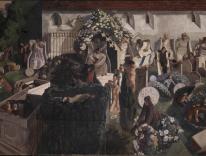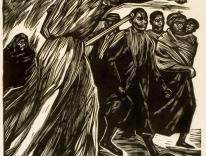My dad loved numbers. The digits that marked daily living—birthdays, anniversaries, addresses, even phone numbers—held particular appeal. After he died, I found countless lottery tickets and scraps of paper scribbled with numbers for everything from daily New York Lotto drawings to Powerball. This was not a random collection of losing tickets; rather, these were logs of my dad’s memories, an archive of his life documented in numbers. Each set of numerals told a story, measured time, recorded moments, re-inscribed relationships—many recognizable to those who were in the know, namely his four kids.
The 2022 baseball season would have delighted my Yankees-fan father (save for the championship series sweep by the Houston Astros). He would have been quick to notice the poetic symmetry found in the quest by outfielder Aaron Judge (whose uniform number is 99) to break the team and American League single season home-run record of sixty-one, set sixty-one years ago in 1961, by outfielder Roger Maris (uniform number 9). Judge broke the record in early October (like Maris) with his sixty-second homer in the 161st game of the 162-game season. I can only imagine my dad’s Powerball ticket telling the story within the confining quirks of a lottery game: 9, 10, 22, 61, 62, with Powerball number 9. Translation: In October 2022 (10, 22) Aaron Judge (9…9, 62) broke the record set in 1961 by Roger Maris, who did it at Yankee Stadium on East 161 St. (9, 61).
Baseball of course is a sport enamored with numbers. A passion for statistics is evident from the earliest box scores, on through the flip-side of baseball cards, and right up to today’s sabermetrics. The so-called science of winning, sabermetrics entails “the search for objective knowledge about baseball.” Each year seems to bring another statistical category, a novel measurement: home-run exit velocity, pitch spin rate, launch angle, and wins above replacement (WAR), my least favorite because of the violent acronym and the reductionist premise that people are hypothetically replaceable. I am still not entirely certain how or even whether knowing such details enhances the fan experience, but increasingly baseball professionals rely on an endless analysis of what appears to be an overwhelming amount of data in order to make a variety of decisions, in the front office and on the field. For fans looking for help to comprehend sportscaster babble, the Society of American Baseball Research (SABR) has a timeline tracing a half-century of sabermetrics history, literature, and highlights, and Major League Baseball provides a glossary of standard and advanced stats.
Quantifiable evidence is thought to guarantee objectivity and, in practice, predict paths to optimum outcomes. An obsession with the accuracy of records also demands a method to make comparisons across players, teams, and time. While some of the metrics attempt to compensate for variables like the favorability of ballpark dimensions, ultimately, the numbers calculate value, often in individual terms that are perceived as context-neutral.
Play on the field is never context-neutral. Beyond his talent and perseverance, Aaron Judge’s accomplishment was made possible by external circumstances like the decision of the manager to place him first in the batting order. This move increased his opportunities to homer, as did the support of teammates whose own play at times helped manufacture additional at-bats.
The debate that swirled around Judge’s march toward number sixty-one also demonstrated that the era in which he is a New York Yankee is not context-neutral. The impact of the steroid era generated ongoing discussion as to whether the “real” record was now sixty-two because it was accomplished “the right way.” Both the National League and MLB single-season records were set in 2001, when San Francisco Giant Barry Bonds hit seventy-three home runs. Three years earlier, in 1998, fans were riveted by the race to surpass Maris between St. Louis Cardinal Mark McGwire and Chicago Cub Sammy Sosa. Both exceeded the record that season (and the next). Most memorably, in 1998, McGwire reached seventy homers, and Sosa, sixty-six. Bonds, McGwire, and Sosa were all later accused of having gained an unfair advantage through their alleged use of performance-enhancing drugs (PED). In the minds of some fans and sports pundits, this renders their achievements null.
Language about the “right way” and the “right player” should raise alarms, as it harkens back to yet another baseball era, one in which a Black player like Judge would not even have had a chance. Judge is the first African American to hit sixty home runs in the American League. In this seventy-fifth anniversary year of Jackie Robinson’s re-integration of Major League Baseball in 1947, it is worth recalling that the euphemistic “right way” imposed unnecessary burdens on him and subsequent pioneering Black and Brown ballplayers. As African-American sports journalist A.S. “Doc” Young noted in his 1963 book Negro Firsts in Sports:
The Negro player had actually to be a better man, and at least as skilled an athlete, as the Caucasian, merely to be considered! ... The Negro had to be college-bred, one of history's greatest all-around athletes, as honest as Jesus, as clean as laundered white-on-white, as pure as Ivory, as emotionless as Sphinx, as cool as the Sky Blue Waters...merely to get the chance.
Young was not exaggerating. His words reflect the history of the Yankees, who held their color line fast for eight more years, finally integrating the team with Elston Howard in 1955, a year before Robinson retired. Black Puerto Rican Vic Power, a top Yankee farm-system prospect, was expected to integrate the team in 1954 but had been traded in December 1953 to the Philadelphia Athletics. As Jackie Robinson explained it simply in his book, Baseball Has Done It, “Vic Power wasn’t the ‘Yankee type.’ Elston Howard was.”
Robinson’s 1964 book functions as a baseball ethnography, capturing the stories of that pioneering generation of African-American and Afro-Latino players in their own unvarnished words. Robinson introduces Power as being among those Afro-Latinos who “react with indignation and refuse to take second-class citizenship in the United States” when confronted with racism. Among the things Power said targeted him for further racial discrimination was his dating of and marriage to a light-skinned, red-haired Puerto Rican woman who was perceived as white. His relationship did not go unnoticed by police, fans, sportswriters, or baseball executives, who didn’t need much of an excuse.
Comparing players across time using formulas to determine who holds a legitimate record is never context-neutral. Which metric evaluates the habit of team owners to look away and profit from the advantages of the steroid era? Which statistic accounts for the stress of playing-while-Black from 1947 to 1959? How can records be accurate if the accounting is incomplete?
In 1961, Elston Howard (number 32) finally became the Yankees starting catcher, and Héctor López (number 11)—the team’s first Afro-Latino—played a pivotal role in their World Series victory. With Maris, among others, López had been acquired from the Philadelphia Athletics in 1959. Ten years later he broke yet another color barrier, becoming the first Black manager in triple-A baseball, piloting the minor league Buffalo Bison. On the opening night of the last homestand of the 2022 regular season, Yankee Stadium observed a moment of silence for López, who had died a day after Judge tied Maris with his sixty-first homer of the year. As my dad knew well, numbers tell far more complicated stories.


